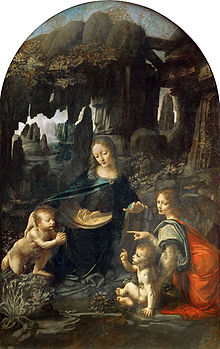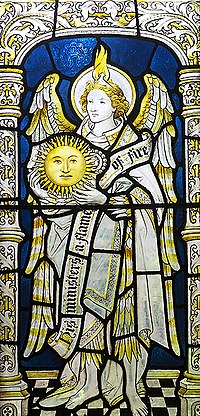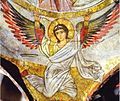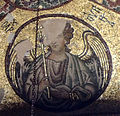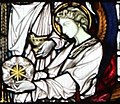Uriel
Uriel | |
|---|---|
 Mosaic of St. Uriel by James Powell and Sons, at St John's Church, Warminster. | |
| Archangel | |
| Venerated in | |
| Feast | 29 September (Western) 8 November (Eastern) 28 July (Ethiopian)[1] |
| Attributes | Archangel; Fire in palm; Carrying a book, a scroll, a flaming sword, a disc of the sun, and a celestial orb or disc of stars and constellations; Holding a chalice (only in Ethiopian Orthodox tradition). |
| Patronage | Arts,[2][3] confirmation, sciences,[4] poetry |
Catholic cult suppressed | 745 by Pope Zachary (Latin Church) |
Uriel (/ˈjʊəriəl/; Hebrew: אוּרִיאֵל "El/God is my light", Standard Hebrew Uriʾel, Tiberian Hebrew ʾÛrîʾēl; Greek: Ουριήλ; Coptic: ⲟⲩⲣⲓⲏⲗ;[5] Italian: Uriele;[6] Geʽez and Amharic: ዑራኤል ʿUraʾēl[7] or ዑርኤል ʿUriʾēl)[8] is one of the archangels of post-exilic rabbinic tradition, and also of certain Christian traditions.
In apocryphal, kabbalistic, and occult works, Uriel has been equated (or confused) with Urial,[9] Nuriel, Uryan, Jeremiel, Vretil, Sariel, Suriel, Puruel, Phanuel, Jacob, Azrael, and Raphael.
In Judaism and Christianity[edit]
Name and origins[edit]
The angels mentioned in the older books of the Hebrew Bible (aka the Tanakh) are without names. Rabbi Simeon ben Lakish of Tiberias (230–270) even asserted that all of the specific names for the angels were brought back by the Jews from Babylon. Of the seven archangels in the angelology of post-exilic Judaism, only two of them, the archangels Michael and Gabriel, are mentioned by name in the canonized Jewish scriptures, in the Book of Daniel in particular, which is one of the youngest books in the Tanakh.
Raphael features prominently in the deuterocanonical Book of Tobit (initially accepted by both the Jewish and Christian canons, but removed from the Jewish canon in late antiquity and rejected by the Protestant reformers in the 16th century). The Book of Tobit is accepted as scriptural by the Roman Catholic Church, the Eastern Orthodox Church, and the Oriental Orthodox Church.
Where a fourth archangel is added to the named three, to represent the four cardinal points, Uriel is generally the fourth.[10] Uriel is listed as the fourth angel in Christian Gnostics (under the name Phanuel), by Gregory the Great,[citation needed] and in the angelology of Pseudo-Dionysius.[citation needed] However, the Book of Enoch clearly distinguishes the two angels. Uriel means "God is my Light", whereas Phanuel means "Turn to God". Uriel is the third angel listed in the Testament of Solomon, the fourth being Sabrael.
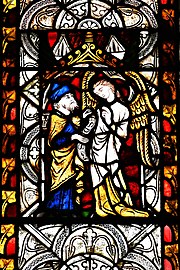
Uriel appears in the Second Book of Esdras[11] found in the Biblical apocrypha (called Esdras IV in the Vulgate) in which the prophet Ezra asks God a series of questions and Uriel is sent by God to instruct him. According to the Revelation of Esdras, the angels that will rule at the end of the world are Michael, Gabriel, Uriel, Raphael, Gabuthelon, Beburos, Zebuleon, Aker, and Arphugitonos. The last five listed only appear in this book and nowhere else in apocryphal or apocalyptic works.
In Christian apocryphal gospels Uriel plays a role, differing between the sources, in the rescue of Jesus' cousin John the Baptist from the Massacre of the Innocents ordered by King Herod. He carries John and his mother Saint Elizabeth to join the Holy Family after their Flight into Egypt. Their reunion is depicted in Leonardo da Vinci's Virgin of the Rocks.
Uriel is often identified as a cherub and the angel of repentance.[12] He "stands at the Gate of Eden with a fiery sword",[13] or as the angel who "watches over thunder and terror".[14] In the Apocalypse of Peter he appears as the angel of repentance, who is graphically represented as being as pitiless as any demon. In the Life of Adam and Eve, Uriel is regarded as the spirit (i.e., one of the cherubs) of the third chapter of Genesis. He is also identified as one of the angels who helped bury Adam and Abel in Eden.
Stemming from medieval Jewish mystical traditions, Uriel has also become the angel of Sunday (Jewish Encyclopedia[full citation needed]), the angel of poetry, and one of the holy sephiroth. Uriel is depicted as the destroyer of the hosts of Sennacherib.
He checked the doors of Egypt for lamb's blood during the plague. He also holds the key to the Pit during the End Times, and led Abraham to the west.
In modern angelology, Uriel is identified variously as a seraph, cherub, regent of the sun, flame of God, angel of the divine presence, presider over Tartarus (hell), archangel of salvation, and, in later scriptures, identified with Phanuel ("face of God"). He is often depicted carrying a book or a papyrus scroll representing wisdom. Uriel is a patron of the arts.
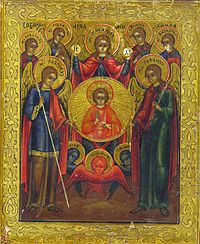
In the Byzantine Catholic and Eastern Orthodox churches, Uriel is commemorated together with the other archangels and angels with a feast day of the "Synaxis of the Archangel Michael and the Other Bodiless Powers" on November 8 of the liturgical calendar (for those churches which follow the Julian Calendar, 8 November falls on 21 November of the modern Gregorian Calendar), and is regarded as the patron saint of the arts and sciences.[4] In addition, every Monday throughout the year is dedicated to the angels. The Anglicans and Coptic Christians of Ethiopia and Eritrea venerate archangel Uriel. According to the latter, 11 July is his feast day.[15] In the Ethiopian Homily on the Archangel Uriel, he is depicted as one of the great archangels, and as the angelus interpres who has interpreted prophecies to Enoch and Ezra, and the helper of both of them. According to the Homily, at the time of the Crucifixion of Jesus, Uriel dipped his wing in the blood and water flowing from Christ's flank and filled a cup with it. Carrying the cup, he and the Archangel Michael rushed into the world and sprinkled it all over Ethiopia, in every place where a drop of blood fell a church was built.[16][17] Thus Uriel is often depicted carrying a chalice filled with the blood of Christ in Ethiopian Orthodox iconography.
In Thomas Heywood's Hierarchy of Blessed Angels (1635), Uriel is described as an angel of the earth. Heywood's list is actually of the angels of the four winds: Uriel (south), Michael (east), Raphael (west) (serving also a governor of the south, with Uriel), and Gabriel (north). He is also listed as an angel of the four winds in the medieval Jewish Book of the Angel Raziel[18] which lists him as Usiel (Uzziel); according to it, this book was inscribed on a sapphire stone and handed down from Seraph to Metatron and then to Adam.
At the Council of Rome of 745, Pope St. Zachary, intending to clarify the Church's teaching on the subject of angels and curb a tendency toward angel worship, condemned obsession with angelic intervention and angelolatry, but reaffirmed the approval of the practice of the reverence of angels. This synod struck many angels' names from the list of those eligible for veneration in the Church of Rome, including Uriel. Only the reverence of the archangels mentioned in the recognised Catholic canon of scriptures, namely Michael, Gabriel, and Raphael, remained licit. In the 16th century, archangel Uriel appeared before the Sicilian friar Antonio Lo Duca and told him to build a church in the Termini area. Lo Duca told pope Pius IV about the apparition, the pope then asked Michelangelo to design the church. It is the church of Santa Maria degli Angeli e dei Martiri, located at the Esedra Plaza.[15]
In the first half of the 11th century, Bulgarian followers of the dualist heresy called Bogomilism, who lived in the dukedom of Ahtum in present-day Banat, invoked Uriel in rituals.[citation needed] This is witnessed by Gerard of Csanád, the Catholic bishop of the area after 1028.[citation needed] Uriel was also named in a small exorcism in the 15th century, reported by Robert Ambelain in Arabic Astrology on page 18, without indication of date, place of origin etc.: "Conjuro te diabolo per sanctum Michaelem, sanctum Gabrielem, sanctum Raphaelem, sanctum Urielem".[19]
In Henry Wadsworth Longfellow's translation of The Golden Legend, Uriel is one of the angels of the seven planets. Uriel is the angel of Mars. He is also listed as such in Benjamin Camfield's A Theological Discourse of Angels (1678).[20]
Possibly Uriel's highest position is that of an angel of presence, prince of presence, angel of the face, angel of sanctification, and angel of glory. A prince of the presence is an angel who is allowed to enter the presence of God. Uriel, along with Suriel, Phanuel, Jehoel, Zagagel, Akatriel, Metatron, Yefefiah, Michael, Gabriel, Raphael, and Nathanel (Zathael) holds this position. The "angel of his presence" title is often taken to mean Shekinah, but it and the other terms mentioned are also often used as alternate names for the angel Metatron. R. H. Charles comments in his translation of The Book of Enoch that in later Judaism "we find Uriel instead of Phanuel" as one of the four angels of the presence.
A scriptural reference to an angel of presence is found in Isaiah 63:9:
In all their affliction he was afflicted, and the angel of his presence saved them: in his love and in his pity he redeemed them; and he bare them, and carried them all the days of old.[21]
In Enoch[edit]

The Book of Enoch, which presents itself as written by Enoch, mentions Uriel in many of its component books. In chapter IX, which is part of "The Book of the Watchers" (2nd century BCE), only four angels are mentioned by name. Those angels are Michael, Uriel, Raphael, and Gabriel (though some versions have a fifth angel: Suryal or Suriel). However, the later chapter XX lists the names and functions of seven angels. Those angels are "Uriel, one of the holy angels, who is over the world and over Tartarus", Raphael, Raguel, Michael, Saraqâêl, Gabriel, and Remiel.
The Book of the Watchers as a whole tells us that Uriel, Raphael, and Gabriel were present before God to testify on behalf of humankind. They wish to ask for divine intervention during the reign of the fallen grigori (fallen watchers). These fallen take human wives and produced half-angel, half-human offspring called the nephilim. Uriel is responsible for warning Noah about the upcoming great flood.
Then said the Most High, the Holy and Great One spoke, and sent Uriel to the son of Lamech, and said to him: "<Go to Noah> and tell him in my name 'Hide thyself!' and reveal to him the end that is approaching: that the whole earth will be destroyed, and a deluge is about to come upon the whole earth, and will destroy all that is on it." [22]
After judgment has been brought upon the nephilim and the fallen ones (see The Book of Giants), including the two main leaders Samyaza and Azazel, Uriel discusses their fates:
And Uriel said to me: "Here shall stand the angels who have connected themselves with women, and their spirits assuming many different forms are defiling mankind and shall lead them astray into sacrificing to demons 'as gods', (here shall they stand,) till 'the day of' the great judgment in which they shall be judged till they are made an end of. And the women also of the angels who went astray shall become sirens.' And I, Enoch alone, saw the vision, the ends of all things; and no man shall see as I have seen."[23]
Uriel then acts as a guide for Enoch for the rest of the Book of Watchers. He fulfills this capacity in many of the other books that make up 1 Enoch.
In Anglican tradition[edit]
In the traditions and hagiography of the Episcopal and other Anglican churches, Uriel is mentioned as an archangel. He is recognized as the Patron Saint of the Sacrament of Confirmation. In some Episcopal churches, Uriel is also regarded as the keeper of beauty and light, and regent of the sun and constellations; in iconography he is shown holding in his right hand a Greek Ionic column which symbolizes perfection in aesthetics and man-made beauty, in his left hand a staff topped with the sun.[3] He is celebrated in the Anglican liturgical calendars on the Feast of the Archangels.[24][25][26][27] The Church of St. Uriel the Archangel in Sea Girt, New Jersey is a testimony to Anglicans' devotion to Uriel.
The Anglican intercessional prayer to Saint Uriel the Archangel is as follows;
Oh holy Saint Uriel, intercede for us that our hearts may burn with the fire of the Sacred Heart of Jesus.
Assist us in co-operating with the graces of our confirmation that the gifts of the
Holy Spirit may bear much fruit in our souls.
Obtain for us the grace to use the sword of truth to pare away all that is not in conformity to the most adorable
Will of God in our lives, that we may fully participate in the army of the Church
Amen[28]
The longstanding motto of the University of Oxford, Dominus illuminatio mea ("The Lord, my light" or, if est is appended to the original and interpolated in translation, "The Lord is my light") is a translation into Latin of Uriel's name.
In esotericism and occult[edit]
In Hermetic Qabalah, Uriel's name is commonly spelled Auriel. He is regarded as the archangel of the North, and of the element of Earth.[29]
According to the teaching of the modern Hermetic Order of the Golden Dawn, Uriel is the archangel of North and of Earth, and is thus associated with the vegetation of the Earth. In iconography he is depicted holding stems of ripened wheat and wearing robes of citrine, russet, olive, and black.[30]
In literature and popular culture[edit]
Literature[edit]
- In Milton's Paradise Lost Book III, Uriel, in charge of the Orb of the Sun, serves as the eyes of God, but unwittingly steers Satan towards the newly created earth. He also fills the role of fourth cardinal point (see above). Milton describes him as the "sharpest sighted spirit in all of Heaven." He is also responsible along with Raphael for defeating Adrammelech.
- In Ralph Waldo Emerson's poem "Uriel", regarded as a poetic summary of many strains of thought in Emerson's early philosophy, Uriel is an archangel in Paradise, who upsets the world of gods by proclaiming relativism and the eternal return.
- In George Eliot's Middlemarch, ch. XLI, to Uriel, "watching the progress of planetary history from the sun, the one result would be just as much of a coincidence as the other".
- In Madeleine L'Engle's book, A Wrinkle In Time, Uriel is a fictional planet of the galaxy Messier 101 with mountains and beautiful flowers.
- In L'Engle's novel Many Waters, Uriel is a character, one of the Seraphim.
- In Dean Koontz's book Hideaway, Uriel speaks and acts through Hatch, one of the book's protagonists, to battle the demon Vassago, who "hitched a ride" with Jeremy Nyebern after he was reanimated.
- In Katherine Kurtz's Deryni novels, Uriel appears along with Gabriel, Raphael and Michael at major rituals in which they are invoked by name as representatives of the four quarters (Uriel's position is the north, and his colour is green); in some instances the four archangels seem to be luminous energy beings that give their mortal viewers the fleeting impression of having wings. Uriel is the angel of death, escorting souls across the line of life to the afterlife. In Camber the Heretic, the ailing King Cinhil Haldane arranges for a ritual to bestow arcane powers on his three young sons to help ensure the Haldane succession; Cinhil dies once the ritual is complete and Uriel stays behind to conduct Cinhil's soul to join those of his deceased wife and firstborn son.
- In Clive Barker's novel Weaveworld, the Scourge declares its eternal name as Uriel. The major character Shadwell recognizes learning "...of all the angels and archangels by heart: and amongst the mighty Uriel was of the mightiest. The archangel of salvation; called by some the flame of God." and "Uriel had been the angel left to stand guard at the gates of Eden."
- Uriel is a character in The Dresden Files book series by Jim Butcher. In Small Favor, Uriel is a subtle but powerful player in the war with the Black Council and the Fallen/Denarians. Called the "Watchman", he only reveals himself to the book's protagonist, Harry Dresden, as a janitor named "Jake". In the novel, Harry receives the power of soulfire and believes that it came from Uriel. He is also referred to as Heaven's "spook". Uriel also appears at the end of Jim Butcher's novella The Warrior, which was released as a part of the anthology, Mean Streets. Uriel appears again in Changes, when Harry Dresden asks him for help, after being paralyzed from the waist down. Uriel tells him that he cannot help him and that he is limited to what he has already done. He also tells Harry that Maggie is indeed his daughter, something that Harry had not been entirely sure of. In Ghost Story, Uriel uses his influence to offer Harry the opportunity to come back to Earth as a spirit to find out the identity of his killer. This is not revealed until close to the end of the book, when Uriel also shows Harry that his friends and family will be okay in his absence. He also shows how Harry was unduly influenced to take up the mantle of the Winter Knight and redresses this imbalance by telling him that Mab, the Winter Queen cannot change who he is. At another point in the book, Uriel becomes enraged when Harry nicknames him "Uri" (omitting "el" (God) from the phrase making up Uriel's name). Unlike his appearances in Small Favor and The Warrior, Uriel's form in Changes and Ghost Story is that of a young man with blond hair, rather than an old janitor. During his appearance in Skin Game, his form is that of an olive-skinned young man with dark hair. He is not bound by linear time, and is responsible for protecting Free Will. The author has described the character as a VP of Creation.
- In Angelglass by David Barnett, Uriel meddles in Earth's affairs and is cast down to see if he can "improve" the course of history by personal intervention.
- In William J. Clark's novel, Winning the Lottery, Uriel is the guardian angel of the narrator, and later of his wife and children. He and the other three archangels, Michael, Gabriel, and Raphael, play an active role in various plot elements, and become a common thread in an attempt to open a dialog between the Western and the Muslim worlds.
- In Richard Kadrey's Kill the Dead, Uriel is one of the original fallen angels and revealed to be the father of protagonist James "Sandman Slim" Stark.
- In Garth Nix's Abhorsen trilogy one of the "nine bright shiners" is named Yrael and appears as a being of living fire.
- In Angelfall by Susan Ee Uriel is shown to be one of the main antagonists of the series, one of the surviving Archangels vying for the role of Messenger.
- In Nalini Singh's romance novel Angels' Blood, Uriel is the target of vampire hunter Elena, who is hired by the archangel Raphael.[31]
Other Media[edit]
- In Haydn's oratorio The Creation, Uriel, voiced by a tenor, is one of the three angelic narrators, along with Gabriel (soprano) and Raphael (bass).
- In the apocrypha of White Wolf Publishing's Vampire: The Masquerade series, Uriel is the last of the angels sent to Cain, after Cain rejects the offers of redemption from Michael, Gabriel, and Raphael. Uriel tells Cain of Golconda, and that it is the last road of redemption open to Cain and his "children".
- In the video game series Darksiders, Uriel is portrayed as the leader of Heaven's armies known as the Hellguard and is depicted as female.
- In the TV show Supernatural, Uriel (played by Robert Wisdom) appears in 4 episodes and is described as a "specialist" when he first appears to series protagonists Dean and Sam Winchester, prepared to wipe out a town in order to prevent an augur of the apocalypse. He is later revealed to be attempting to ensure Lucifer's release while killing other angels, but is killed in a confrontation with the renegade angel Anna Milton. A past version of Uriel appears in the episode "The Song Remains the Same" when Anna travels back in time to stop the Apocalypse by killing Dean and Sam's parents before they can have children, as Michael and Lucifer can only wage their apocalyptic final battle if Dean and Sam will consent to act as their vessels on Earth. Anna tricks the younger Uriel into helping her attack the Winchesters, but Uriel is subsequently banished and his memories erased by Michael, who uses the Winchesters' father John as a temporary vessel.
- In the TV show Lucifer, Uriel (appearing in 2 episodes, played by Michael Imperioli) is a minor antagonist of the main character with the power to understand innate patterns.
- In Highschool DxD, the mythological angel Uriel is one of the Four Great Seraphs alongside Michael, Gabriel and Raphael, being the only Angel who inherited the Flame of God, having powers to manipulate divine flames.
Gallery[edit]
Fresco of archangel Uriel at the Hanging Church in Cairo, 13th century
14th-century Russian mosaic fragment of Uriel
Mosaic of archangel Uriel in Hosios Loukas
Archangel Uriel depicted on Pala d'Oro, St Mark's Basilica, Venice
18th-century Cuzco School painting of Uriel as a warrior angel
Uriel Standing in the Sun by Washington Allston, 1817
Archangel Uriel, fresco at the ceiling by Johann Georg Unruhe from Saint Michael parish church, Untergriesbach, 1780
Archangel Uriel as the regent of constellations, St Martin in the Bull Ring
Statue of archangel Uriel at the San Miguel Church
Mural of archangel Uriel by Henry O. Walker in Thomas Jefferson Building, inspired by Emerson's poem Uriel
Statue of archangel Uriel at the Old Cemetery of Paysandú
Carving of St Uriel at St Augustine's, Kilburn
A stained glass window of Uriel in St. Anthony of Padua Catholic Church (Dayton, Ohio)
Uriel as the regent of the sun and of constellations, St Andrew's Church, Chippenham
St Uriel as the regent of constellations, St Mary the Virgin's Church, Lynton
Stained glass of St Uriel at the Church of St James, Grimsby
Stained glass of St Uriel at the Holy Trinity Church, Hull
See also[edit]
- Hierarchy of angels
- Homily on the Archangel Uriel
- List of angels in theology
- St. Uriel's Episcopal Church
- Uriel's Machine (linked to archaeoastronomy and 'Genesis flood narrative')
Notes[edit]
- ^ Bunson, Matthew (2010). Angels A to Z: A Who's Who of the Heavenly Host. New York: Potter/Ten Speed/Harmony/Rodale. p. 103. ISBN 9780307554369.
In the orthodox churches of Egypt and Ethiopia, the Christians celebrate July 28 in honor of the archangel Uriel.
- ^ "Window 33: Archangel Uriel". stpaulswinstonsalem.org. Retrieved 3 April 2019.
He is a patron of the arts and the patron saint of the sacrament of Confirmation.
- ^ a b "Christ Triumphant (High Altar)". www.stjohnsmemphis.org. Retrieved 3 April 2019.
He is the keeper of beauty and light […] He holds in his right hand a Greek Ionic column which symbolizes perfection in aesthetics and man-made beauty.
- ^ a b "Архангел Уриил" [Archangel Uriel]. www.temples.ru (in Russian). Retrieved 15 May 2019.
Уриил — это небесный огонь, покровитель тех, кто посвятил себя наукам и искусствам.
- ^ "The Apocryphon of John". marcion.sourceforge.net. 1 April 2011. Retrieved 12 December 2017.
- ^ Stanzione, Marcello; Alvino, Carmine (2017). Uriele: L'arcangelo Scomparso [Uriel: The Lost Archangel] (in Italian). Milan: SugarCo Edizioni. ISBN 978-88-7198-716-3.
- ^ Täsfa Mikaʾel Gäbrä Śǝllase (1992–1993). "ድርሳነ፡ ዑራኤል። ግዕዝና፡ አማርኛ። መልክአ፡ ዑራኤል፡ በልሳነ፡ ግዕዝ። (Dǝrsanä ʿUraʾel gǝʿǝzǝnna amarǝňňa—mälkǝʾa ʿUraʾel bälǝssanä gǝʿǝz, 'Homiliary on [the honour of] Uriel in Gǝʿǝz, Tigrinya and Amharic—Image of Uriel in Gǝʿǝz')". zotero.org. Retrieved 15 June 2019.
- ^ Tefera, Amsalu; Bausi, Alessandro; Tafla, Bairu; Braukämper, Ulrich; Gerhardt, Ludwig; Meyer-Bahlburg, Hilke; Uhlig, Siegbert (2018). "A Fifteenth-Century Ethiopian Homily on the Archangel Uriel". Aethiopica: International Journal of Ethiopian and Eritrean Studies. 21: p. 89. ISBN 978-3-447-18045-0. Retrieved 16 June 2019.
- ^ Forward Day by Day, August–September–October 2011, p. 61, entry for September 29, 2011.
- ^ Jewish Encyclopedia
- ^ 2 Esdras 4:1; 5:20; 10:28
- ^ Book of Adam and Eve
- ^ Abbot Anscar Vonier (1964). The Teaching of the Catholic Church.
- ^ 1 Enoch 20:2
- ^ a b "The story of Uriel, the 'forgotten' archangel". www.romereports.com. Rome Reports. 27 November 2011. Retrieved 28 October 2017.
- ^ Böll, Verena, ed. (2004). Studia Aethiopica. Wiesbaden: Otto Harrassowitz Verlag. p. 440. ISBN 9783447048910.
- ^ Houlden, James Leslie (2003). Jesus in History, Thought, and Culture: An Encyclopedia, Volume 1. Santa Barbara, California: ABC-CLIO. p. 265. ISBN 9781576078563.
- ^ Sepher Rezial Hemelach
- ^ Stanzione, Marcello; Alvino, Carmine (2011). "Le attestazioni dirette e accreditate dell'arcangelo Uriele in ambito cristiano-cattolico". Inchiesta su Uriele: l'Arcangelo scomparso (in Italian). Tavagnacco: Edizioni Segno. p. 149. ISBN 978-88-6138-407-1.
IV. Attestazione: Uriele invocato in un esorcismo — Uriele era anche nominato in un piccolo esorcismo del XV secolo, riportato da Robert Ambelain in Astrologia Araba a pag. 18, senza indicazione di data, luogo datazione ecc: "Conjuro ... Urielem".
- ^ Canfield, A Theological Discourse of Angels, Wherein Their Existence, Nature, Number, Order and Offices, are modestly treated of...
- ^ Isaiah 63:9
- ^ 1 Enoch 10:1-4
- ^ 1 Enoch 19:1-3
- ^ Lesser Feasts and Fasts, p. 380.
- ^ Anglican.org website Michaelmas page. Retrieved September 15, 2008.
- ^ St. George's Lennoxville website, What Are Anglicans, Anyway? page Archived 2008-09-26 at the Wayback Machine. Retrieved September 15, 2008.
- ^ Christ Church Eureka website, September Feasts page Archived 2008-05-11 at the Wayback Machine. Retrieved September 15, 2008.
- ^ "Our Patron Saint". www.urielsg.org. Retrieved 28 August 2018.
- ^ Case, Paul Foster (1989). The True and Invisible Rosicrucian Order. New York: Weiser Books. p. 291. ISBN 9780877287094.
- ^ "Uriel: Archangel of Earth". www.hermeticgoldendawn.org. Retrieved 3 September 2018.
- ^ "Angels' Blood - Nalini Singh -". BusyMomsBookReviews.
Further reading[edit]
- Bamberger, Bernard Jacob, (March 15, 2006). Fallen Angels: Soldiers of Satan's Realm. Jewish Publication Society of America. ISBN 0-8276-0797-0
- Briggs, Constance Victoria, 1997. The Encyclopaedia of Angels: An A-to-Z Guide with Nearly 4,000 Entries. Plume. ISBN 0-452-27921-6.
- Bunson, Matthew, (1996). Angels A to Z: A Who's Who of the Heavenly Host. Three Rivers Press. ISBN 0-517-88537-9.
- Cruz, Joan C. 1999. Angels and Devils. Tan Books & Publishers. ISBN 0-89555-638-3.
- Davidson, Gustav. A Dictionary of Angels: Including the Fallen Angels. Free Press. ISBN 9780029070505
- Ivánka, E. von, "Gerardus Moresanus, der Erzengel Uriel und die Bogomilen", Orientalia Christiana Periodica 211-2 (1955) (Miscellanea Georg Hofmann S.J.), pp 143–146.
- Guiley, Rosemary, 1996. Encyclopaedia of Angels. ISBN 0-8160-2988-1
- The Book Of Enoch translated by R. H. Charles D.LITT., D.D. with an introduction by W. O. E. OESTERLEY, D.D., Charles. H. R, 1917
- Longfellow, Henry Wadsworth, 1807–1882. The Golden Legend
- Heywood, Thomas, 1634–1635. The Hierarchy of the Blessed Angels
- Waite, Arthur Edward, 1913. The Book of Ceremonial Magic Second Edition of The Book of Black Magic and of Pacts.
- Stanzione, Marcello; Alvino, Carmine (2011). Inchiesta su Uriele: l'Arcangelo scomparso [Investigation of Uriel: The Lost Archangel] (in Italian). Tavagnacco: Edizioni Segno. ISBN 978-88-6138-407-1. OCLC 878792290.
External links[edit]
| Wikimedia Commons has media related to Archangel Uriel. |
- Jewish Encyclopaedia: Uriel
- Judaism FAQs: What about angels, demons, miracles, and the supernatural?
- Victor Sensenig, "Always the seer is a sayer": Themes of seeing in Paradise Lost with Milton's use of Uriel.
- Emerson's Uriel
- Online copy of the golden legend
